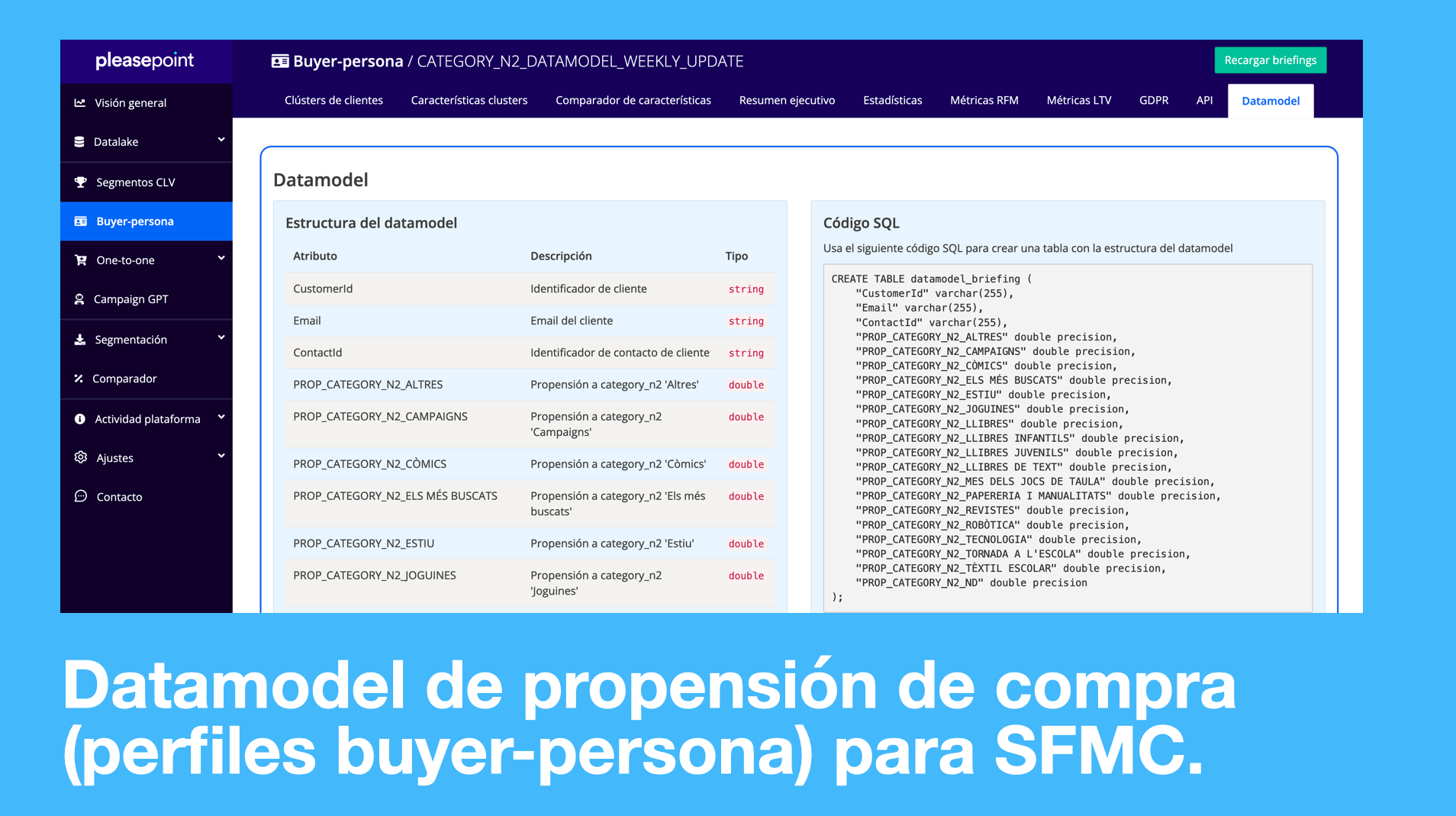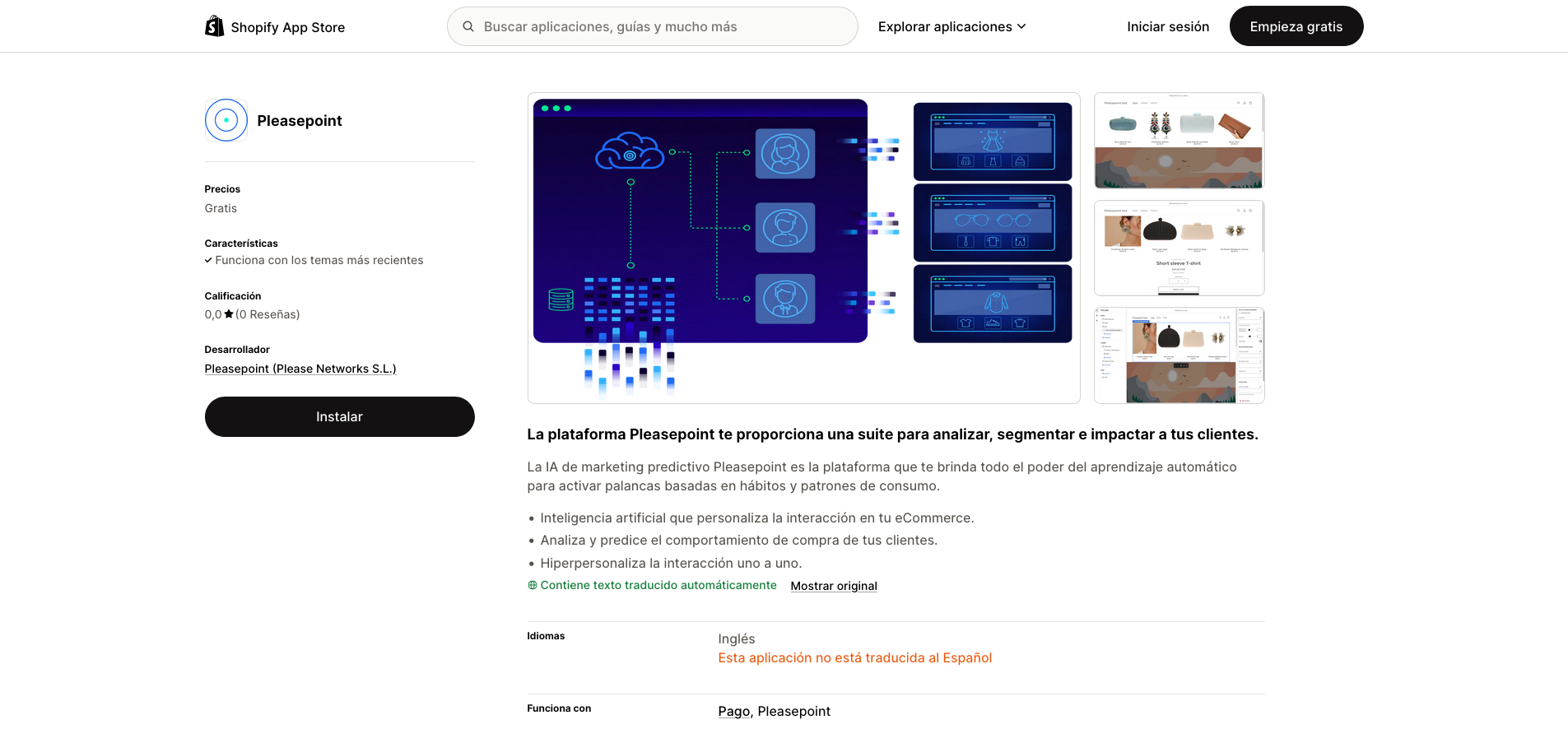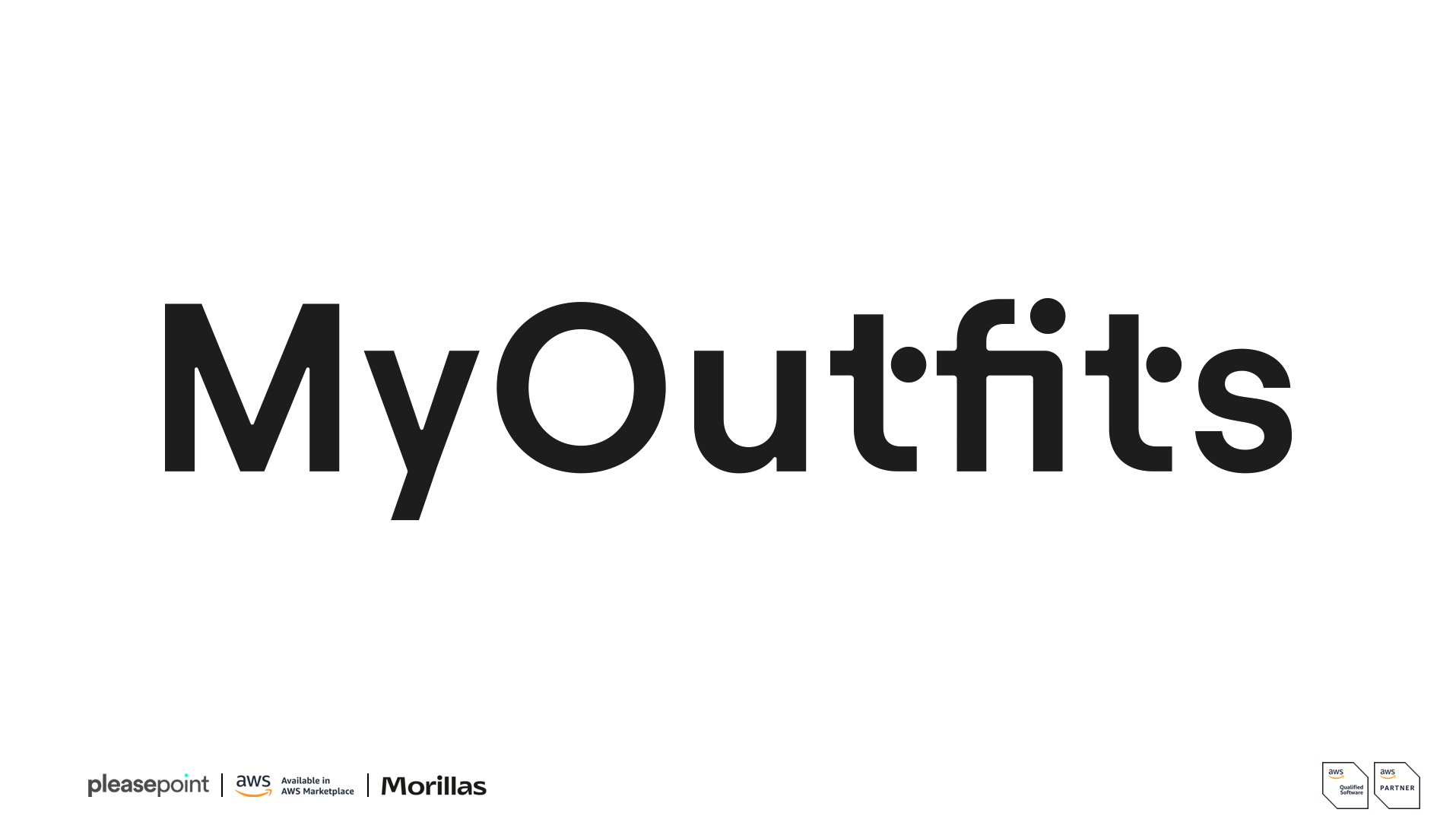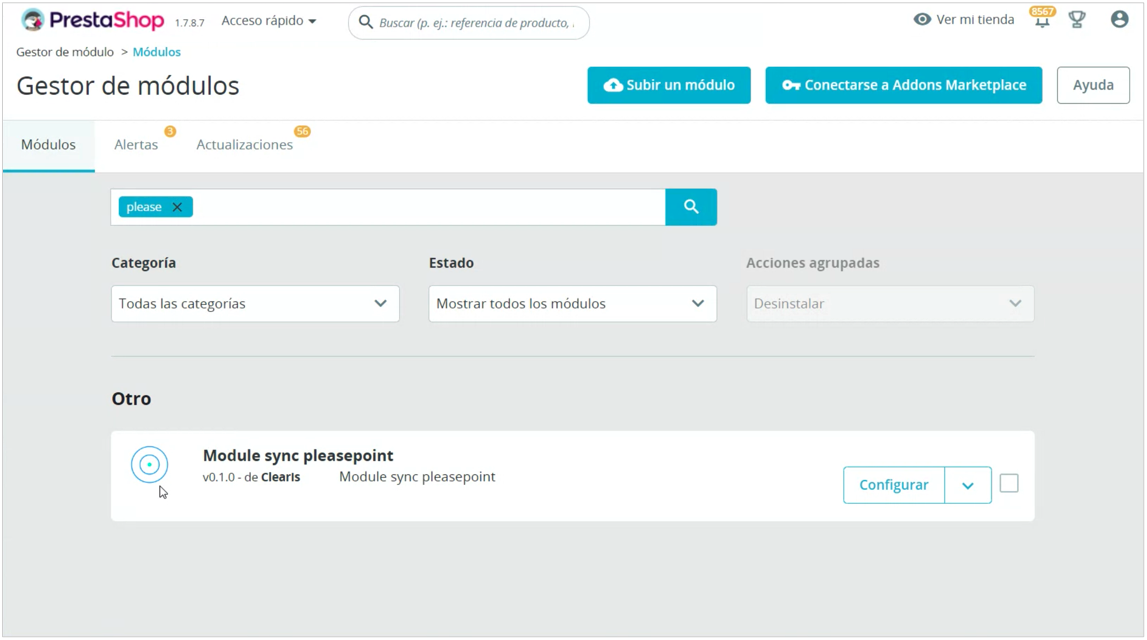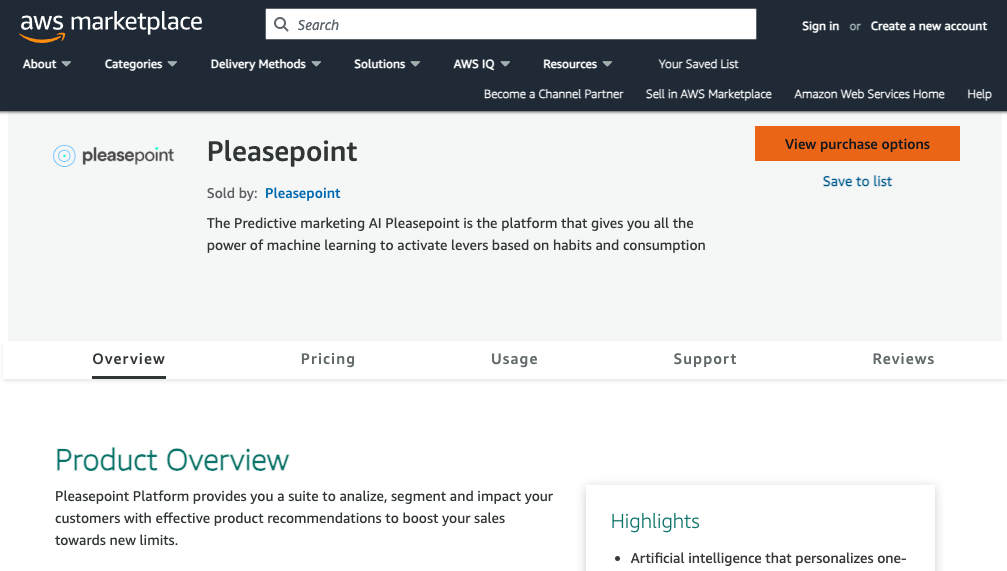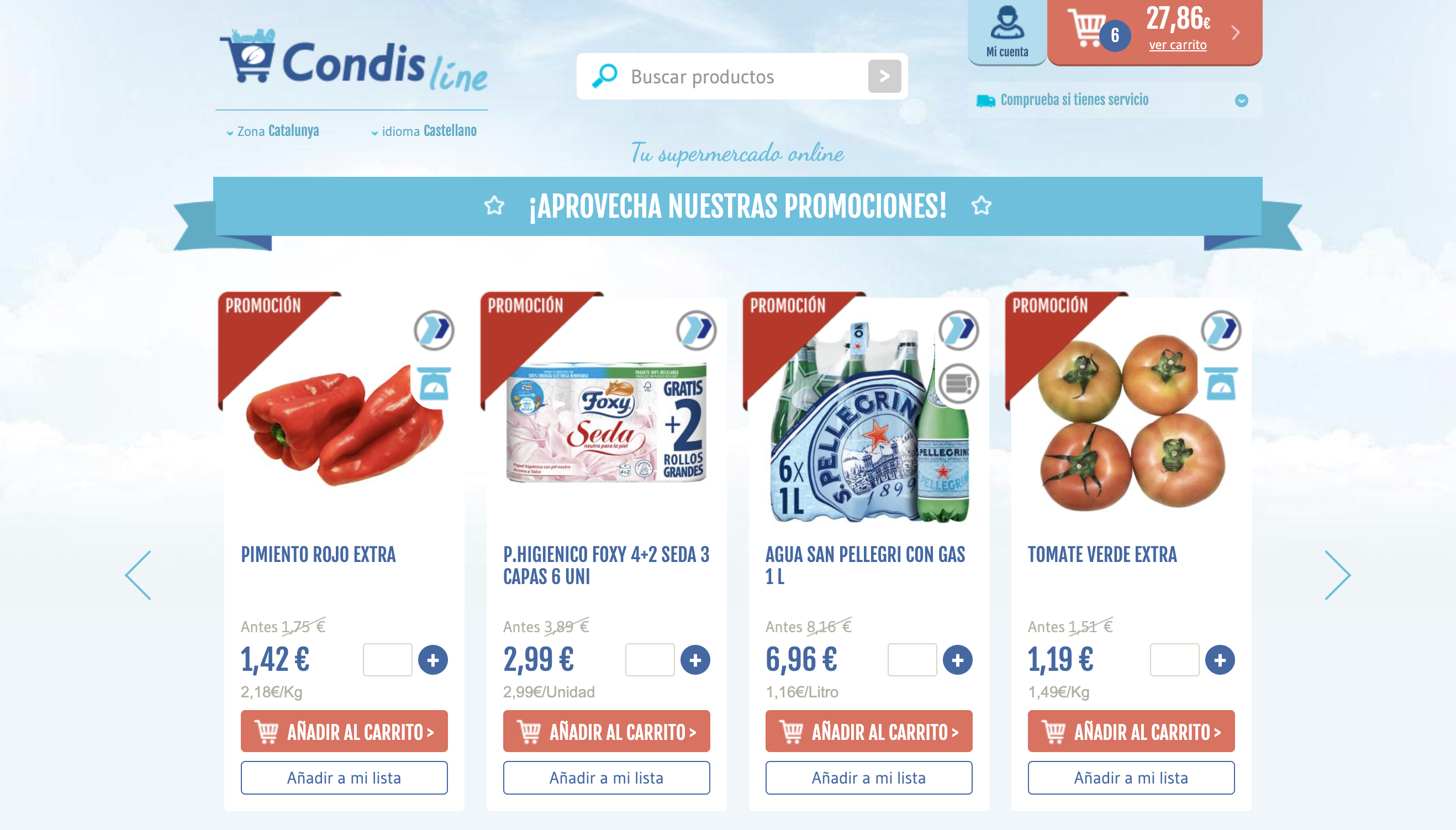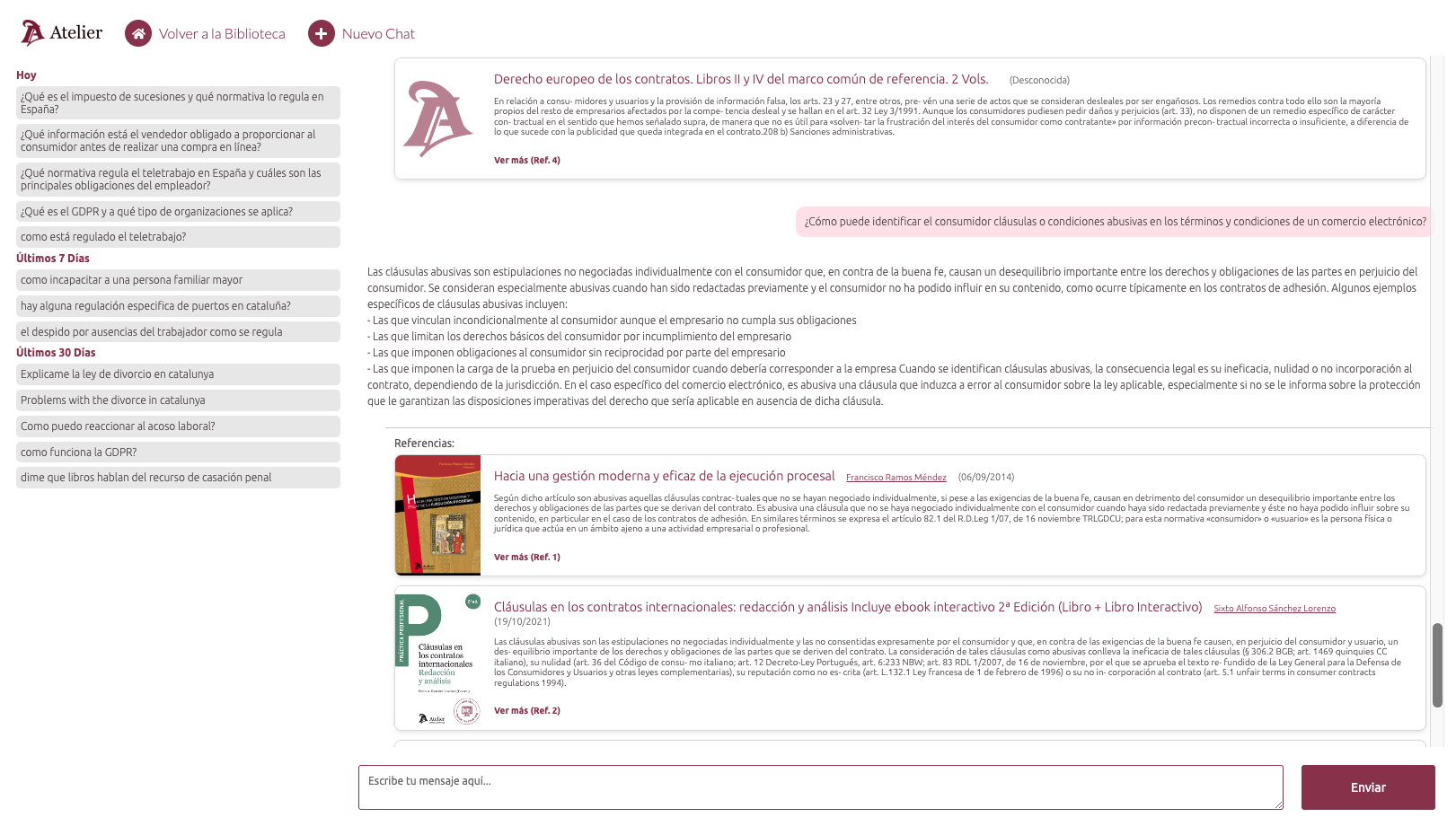In this article, we will explore in detail how to enrich technological solutions like Salesforce Marketing Cloud and other CRM/CDP systems or Data Lakes with information from the customer classification model based on purchase propensity.
Here is the article content:
- What is a datamodel?
- Customer classification based on purchase propensity
- Structure of the purchase propensity datamodel
- Use cases of the purchase propensity datamodel (buyer-persona)
- Examples of personalization based on purchase propensity
- Benefits of using the buyer-persona datamodel in SFMC
Generic communication strategies are no longer enough to attract and retain consumers. The key to success lies in hyper-personalizing communications, an approach that has proven not only effective but an imperative necessity.
Imagine this: you’re in a room full of people, all shouting their messages at the same time. In this deafening chaos, how many messages would you actually hear and process?
This is how your customers feel in today's digital world. The average promotional email is just one of many voices in the crowd. To stand out and establish a genuine connection with your audience, you need to speak their language, address their specific needs, and anticipate their desires.
This is where hyper-personalization comes into play.
One of the most powerful tools for achieving this is the concept of "purchase propensity." This is essentially the art of predicting what your customers will want before they even know it themselves.
How is this possible?
Through advanced data analysis and artificial intelligence. Imagine having the ability to anticipate your customers' preferences, offering them exactly what they want, even before they search for it. This doesn't just sound futuristic—it’s a reality that many leading companies are already immersed in.
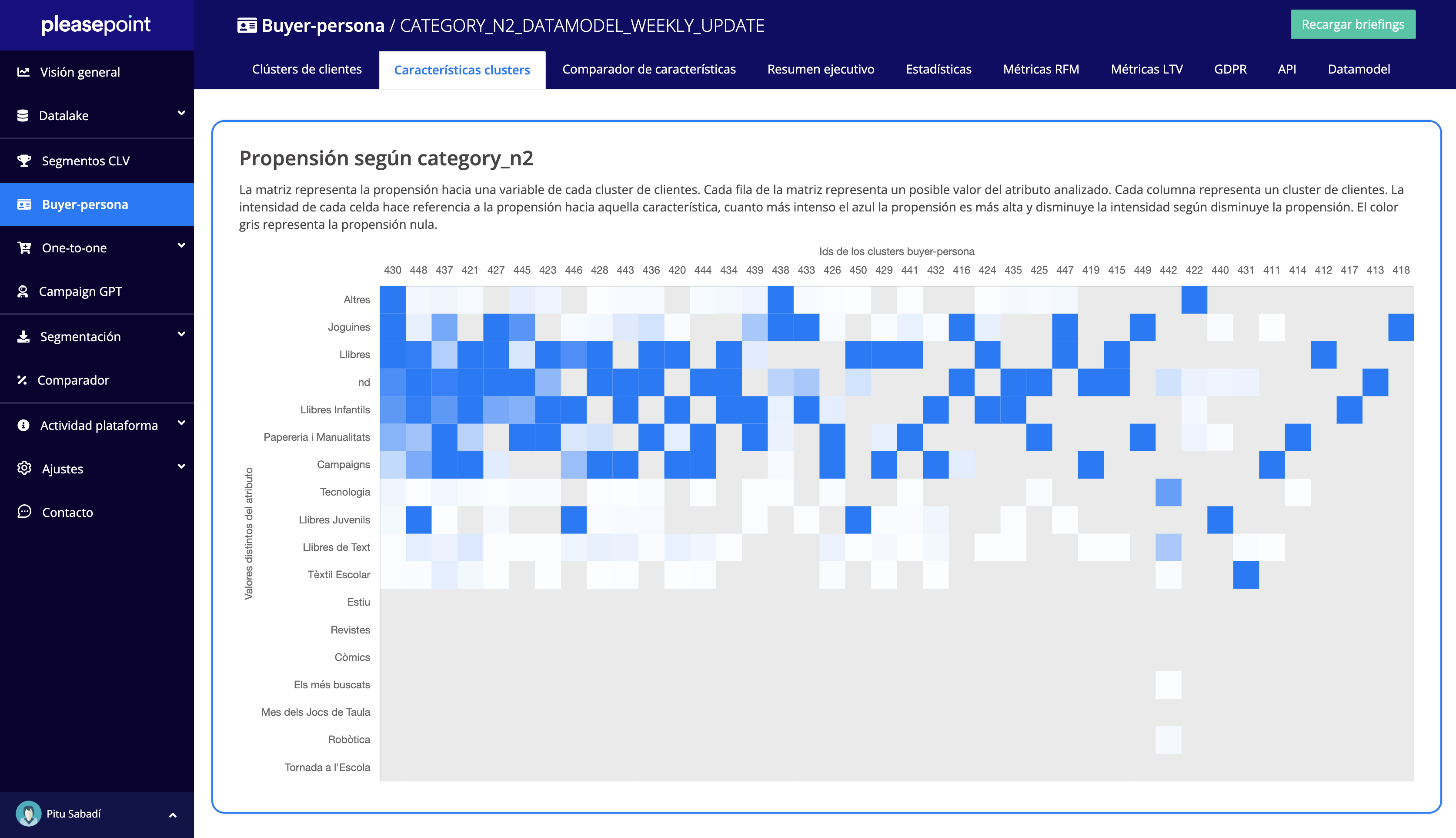
To better understand how this works, let’s consider a concrete example. Suppose you run an online store that sells a wide variety of products, from books to electronics and toys.
With the right information and a Purchase Propensity Datamodel, you can identify customers showing high interest in, say, science fiction books. Then, you can design a specific marketing campaign for this group of "science fiction lovers."
This doesn't just involve sending them relevant book recommendations but also offering exclusive discounts on the latest releases in that genre. As a result, you become their go-to store, increasing the likelihood that they will make a purchase.
The benefits of this hyper-personalization are abundant.
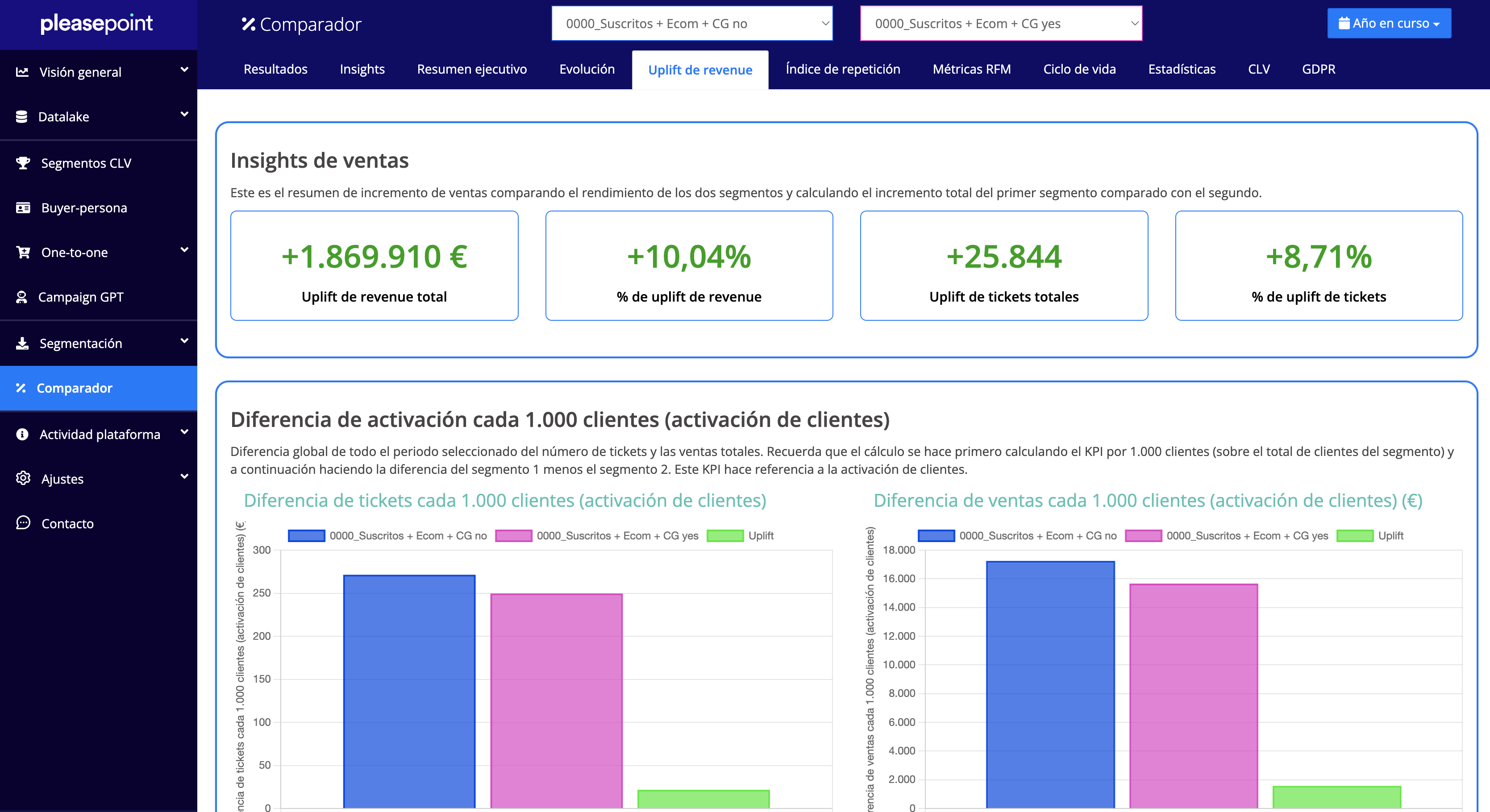
Not only does it improve the customer experience by providing what they truly want, but it also significantly increases conversion rates. Additionally, it reduces the churn caused by irrelevant campaigns and strengthens customer loyalty.
In short, personalization is not just a trend in marketing—it’s a necessary strategy to stand out in the crowded digital landscape and create deeper, longer-lasting connections with your customers.
This article sets the stage to delve deeper into how purchase propensity and hyper-personalization are shaping the future of marketing.
Here are five previous blog posts I think you might find interesting:
- Maximizing conversion and loyalty through personalization..
- Turning data into sales growth: A case study on hyper-personalization in CRM strategy..
- The control group: the key to measuring the impact of your CRM actions..
- Enriching Salesforce Marketing Cloud with the Customer Lifetime Value (CLV) Datamodel..
- One-to-one personalization for your actions in Salesforce Marketing Cloud..
- Pleasepoint selected at AWS Summit Madrid 2023 as one of the 20 most innovative startups..
What is a datamodel?
In the Pleasepoint ecosystem, a datamodel is a highly specialized CSV file that is periodically updated. This file is a treasure trove of information about your customers.
The primary function of the Purchase Propensity Datamodel is to predict, with great accuracy, each customer's purchase preferences regarding various product categories available in your business.
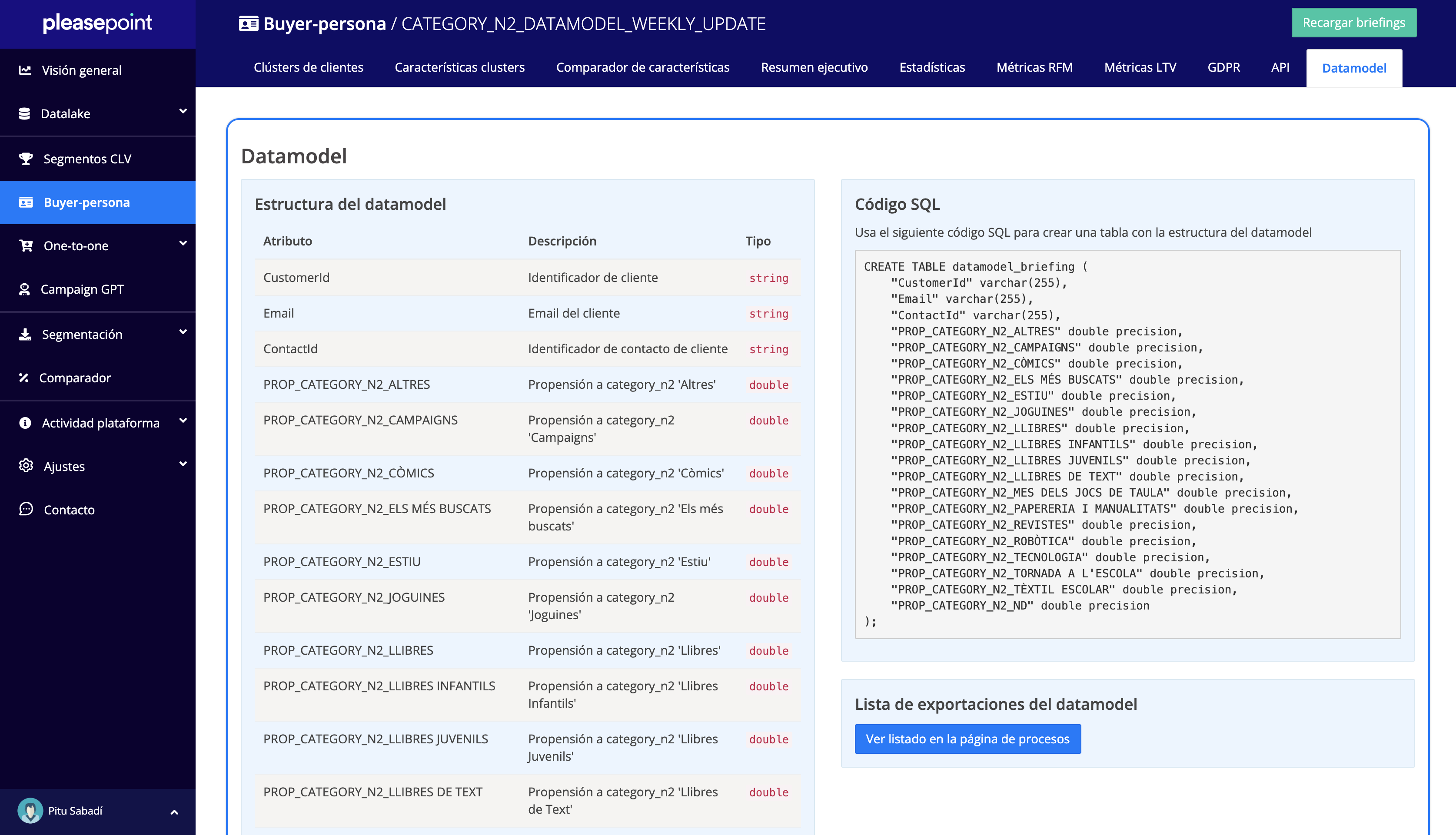
The Purchase Propensity Datamodel becomes a fundamental tool for any advanced marketing strategy. Its power lies in its ability to significantly enrich your customer database.
It’s no longer just about knowing their demographics and past behaviors. Now, you can understand their purchase preferences in surprising detail.
This data enrichment enables something extraordinary: micro-segmentation of your audience. You're no longer treating all your customers the same. Instead, you can divide them into smaller, more specific groups based on their purchase affinities.
This opens the door to hyper-effective personalization in all your CRM actions, from email marketing campaigns to promotional offers.
While this article focuses on integrating the Purchase Propensity Datamodel into Salesforce Marketing Cloud (SFMC), it's important to note that its versatility knows no bounds.
You can enrich virtually any customer database or use it in conjunction with Customer Data Platforms (CDPs) to further enhance the accuracy of your segmentations and personalizations.
Pleasepoint's Purchase Propensity Datamodel is the key to unlocking hyper-personalization in your CRM strategies. Through advanced data analysis and artificial intelligence, it allows you to anticipate your customers' purchase preferences and offer them unique experiences. Next, we will explore how you can make the most of this powerful resource in Salesforce Marketing Cloud.
Remember that to use the Pleasepoint Datamodel with Salesforce Marketing Cloud, you must first configure sFTP access to the platform.

Once sFTP is correctly configured, you will have automated access to the massive data export generation for each customer in the Customer Lifetime Value-based Segmentation section.
In the article One-to-one personalization for your actions in Salesforce Marketing Cloud., you'll see how to import the one-to-one product recommendation datamodel into Salesforce Marketing Cloud, using our deep learning engine to offer each customer the best products at any time.
Customer classification based on purchase propensity.
The true value of the Pleasepoint Purchase Propensity Datamodel lies in its ability to classify your customers based on their propensity to make purchases in specific categories.
Do you have customers interested in comics, technology, or any other category?
This datamodel will provide detailed information on each customer's individual preferences. This, in turn, will allow you to adapt your marketing strategies in a precise and effective way.
One of the standout advantages of this datamodel is its flexibility. You can create a purchase propensity model for virtually any product attribute you desire.
Do you want to know which customers are more likely to buy comics, tech products, or any other type of product in your catalog?
With this datamodel, you have the ability to get precise answers.
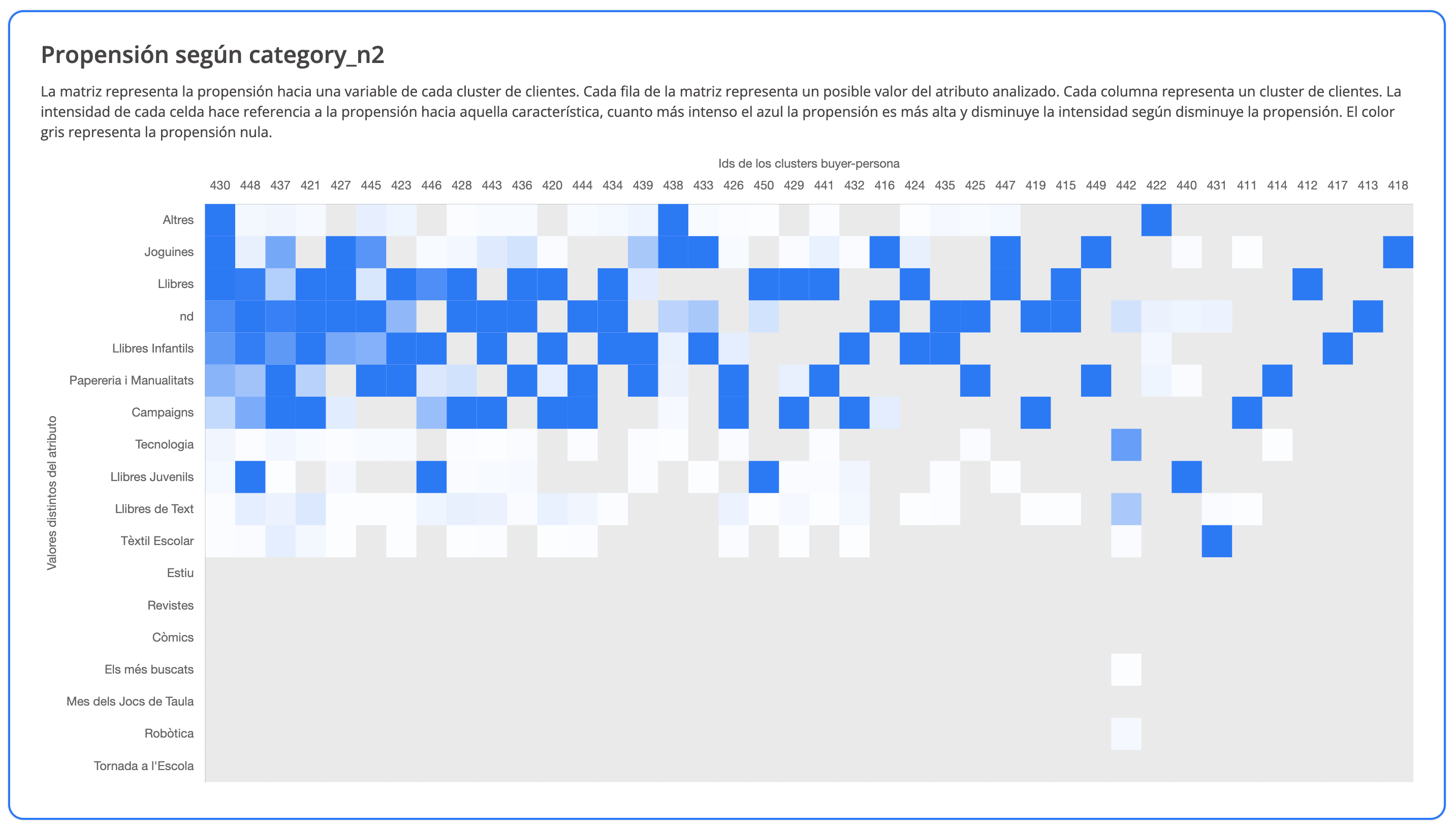
Segmentation is essential in marketing, and the Purchase Propensity Datamodel provides you with the tools needed to segment your customers' information based on their behaviors and preferences.
You can use the segmentation module to classify customers into groups with similar purchase propensities. This segmentation allows you to target specific strategies to each group, maximizing the relevance of your communications and increasing the chances of conversion.
Take a look at the propensity results from the example we are following:
| ID | Name | Description | Number of Customers |
|---|---|---|---|
| 412 | Llibres_Altres_Llibres de Text | Customers with a propensity to buy textbooks and other products. | 18,927 |
| 411 | Campaigns_Joguines_Llibres de Text | Customers interested in campaigns, toys, and textbooks. | 10,016 |
| 413 | nd_Llibres de Text_Els més buscats | Customers who prefer textbooks and highly sought-after products. | 9,937 |
| 418 | Joguines_Tecnologia_Tèxtil Escolar | Customers interested in toys, technology, and school supplies. | 8,350 |
| 419 | Campaigns_nd_Llibres de Text | Customers who respond well to campaigns and are interested in textbooks. | 8,137 |
| 414 | Papereria i Manualitats_Tecnologia_Llibres de Text | Customers interested in stationery, technology, and textbooks. | 5,903 |
| 417 | Llibres Infantils_Llibres de Text_Tèxtil Escolar | Customers interested in children's books, textbooks, and school supplies. | 4,865 |
| 429 | Campaigns_Llibres_Papereria i Manualitats | Customers who respond positively to campaigns and show interest in books and stationery. | 3,333 |
| 415 | Llibres_nd_Llibres de Text | Customers who prefer textbooks and other products. | 2,879 |
| 424 | Llibres_Llibres Infantils_Joguines | Customers interested in books, children's books, and toys. | 2,610 |
Not all marketing strategies require long-term analysis. You can limit the analysis period for classifying customers based on their purchase propensity.
This is especially useful when you want to tailor your strategies based on temporary or seasonal events, like Christmas campaigns or summer promotions. The ability to adjust the analysis time frame gives you more control over your marketing actions.
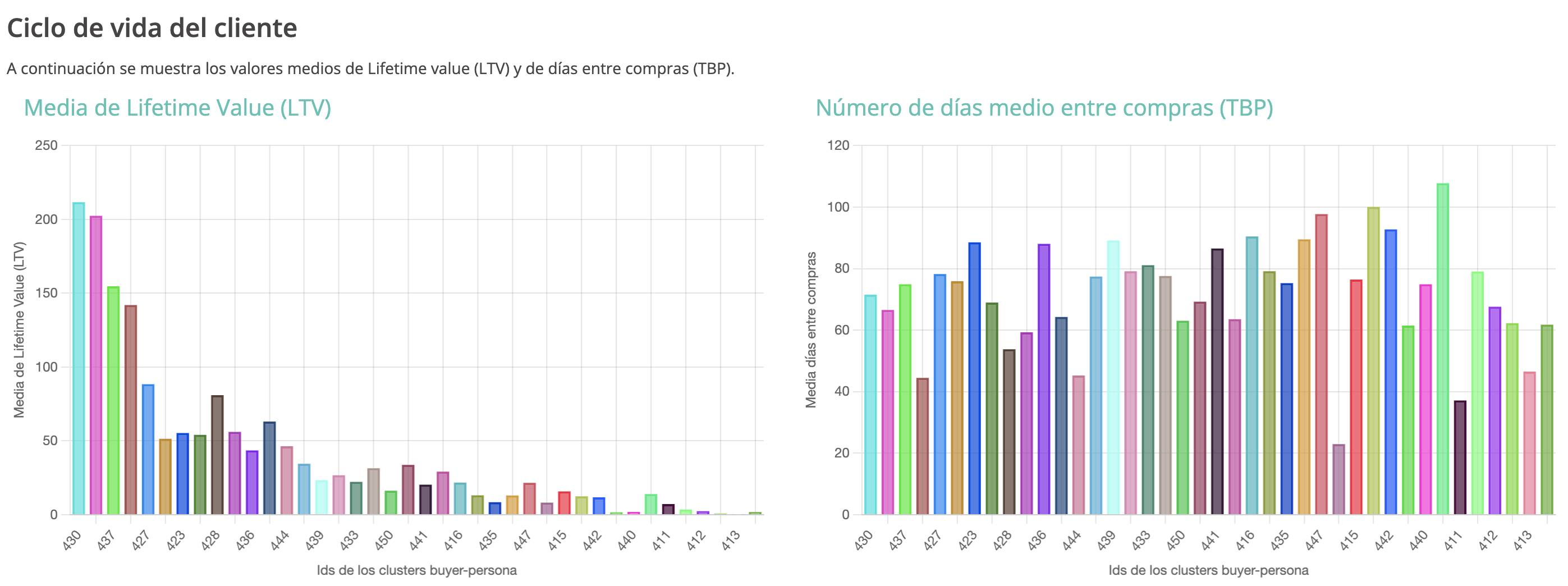
One of the primary goals of this datamodel is to enrich your customer information in your Customer Relationship Management (CRM), Customer Data Platform (CDP), or any other customer database you use.
Purchase propensity becomes a valuable attribute that helps you understand your customers more deeply. With this enriched information, you can create hyper-personalized strategies that increase customer retention and loyalty.
In summary, the customer classification based on purchase propensity provided by the Pleasepoint Datamodel is an invaluable tool for any marketing strategy.
It gives you precise, detailed information about your customers' individual preferences, enables you to segment audiences effectively, and enriches your customer database with valuable data for precise personalization. This translates into more effective marketing actions and, ultimately, greater business success.
Structure of the purchase propensity datamodel.
The Pleasepoint Purchase Propensity Datamodel is built on a solid, meticulous structure that stores crucial information. Each of its attributes acts as a building block, creating a deep and precise understanding of your customers when combined. Let’s break down the structure that empowers your marketing strategy:
- CustomerId: This attribute serves as the unique identifier for each customer. It’s the key that links all other data, enabling individualized tracking.
- Email: Email is a fundamental element for personalized communication. It facilitates sending offers, recommendations, and relevant content.
- ContactId: The customer contact identifier adds depth to the identification process, offering a more complete view of a customer’s interaction across multiple channels and platforms.
- PROP_ATRIBUTE_XXXX: These attributes are the essence of the Purchase Propensity Datamodel. Each one represents a customer’s propensity towards a specific attribute in the data model, from product categories to promotions. Each propensity is evaluated and assigned a value indicating how likely a customer is to purchase in that area.
This detailed structure allows for highly precise segmentation. It’s no longer about “customers who buy books.” Now, you can differentiate between those with a strong propensity for children's books and those who prefer textbooks, tailoring your messages accordingly.
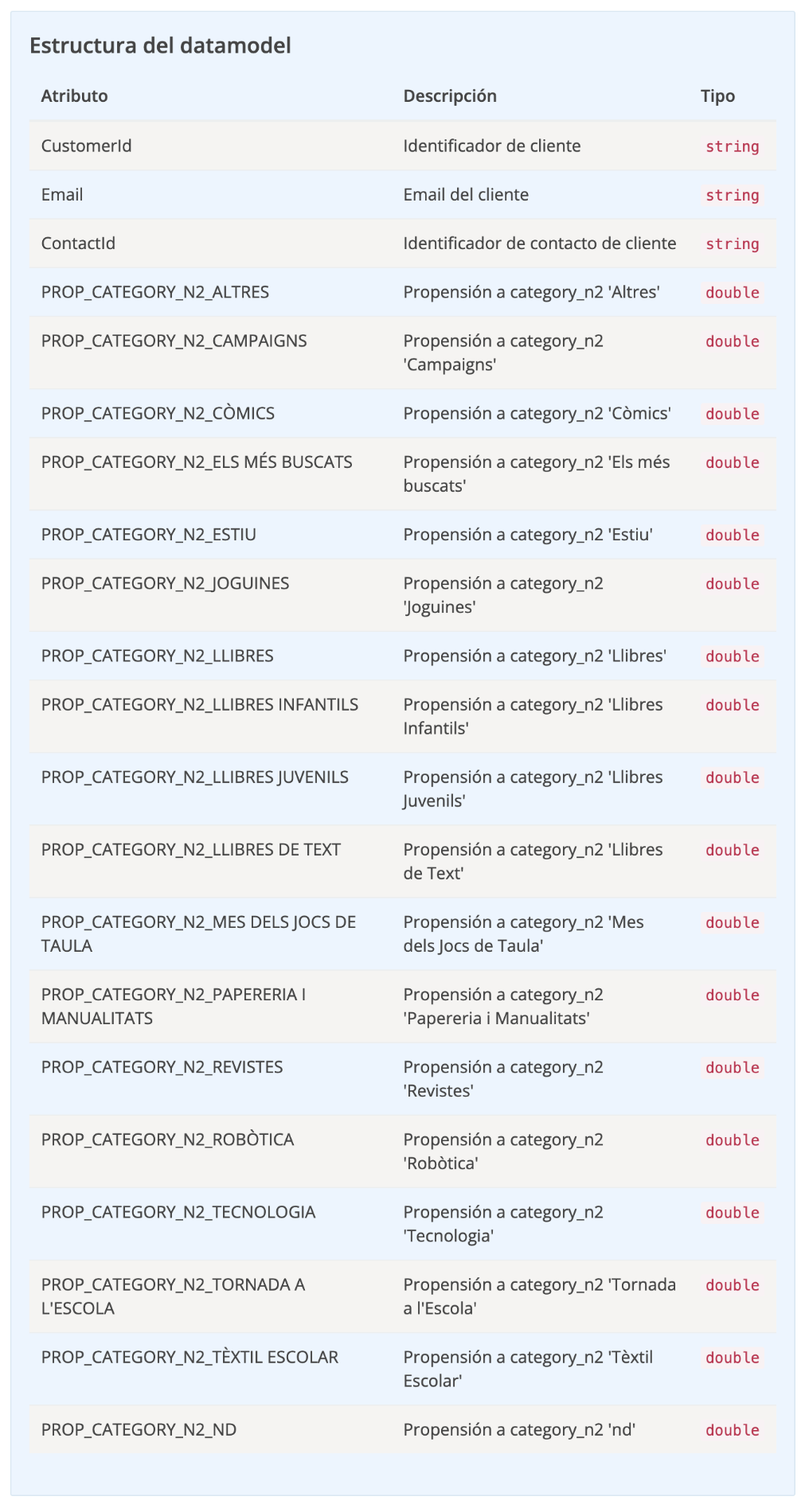
In the next section, we will dive deeper into configuring the Pleasepoint Purchase Propensity Datamodel to help you maximize this valuable resource.
Configuring the Pleasepoint purchase propensity datamodel.
To fully harness this hyper-personalization tool, precise configuration of your Purchase Propensity Datamodel is essential. Accurate data collection and storage are the pillars of its optimal performance.
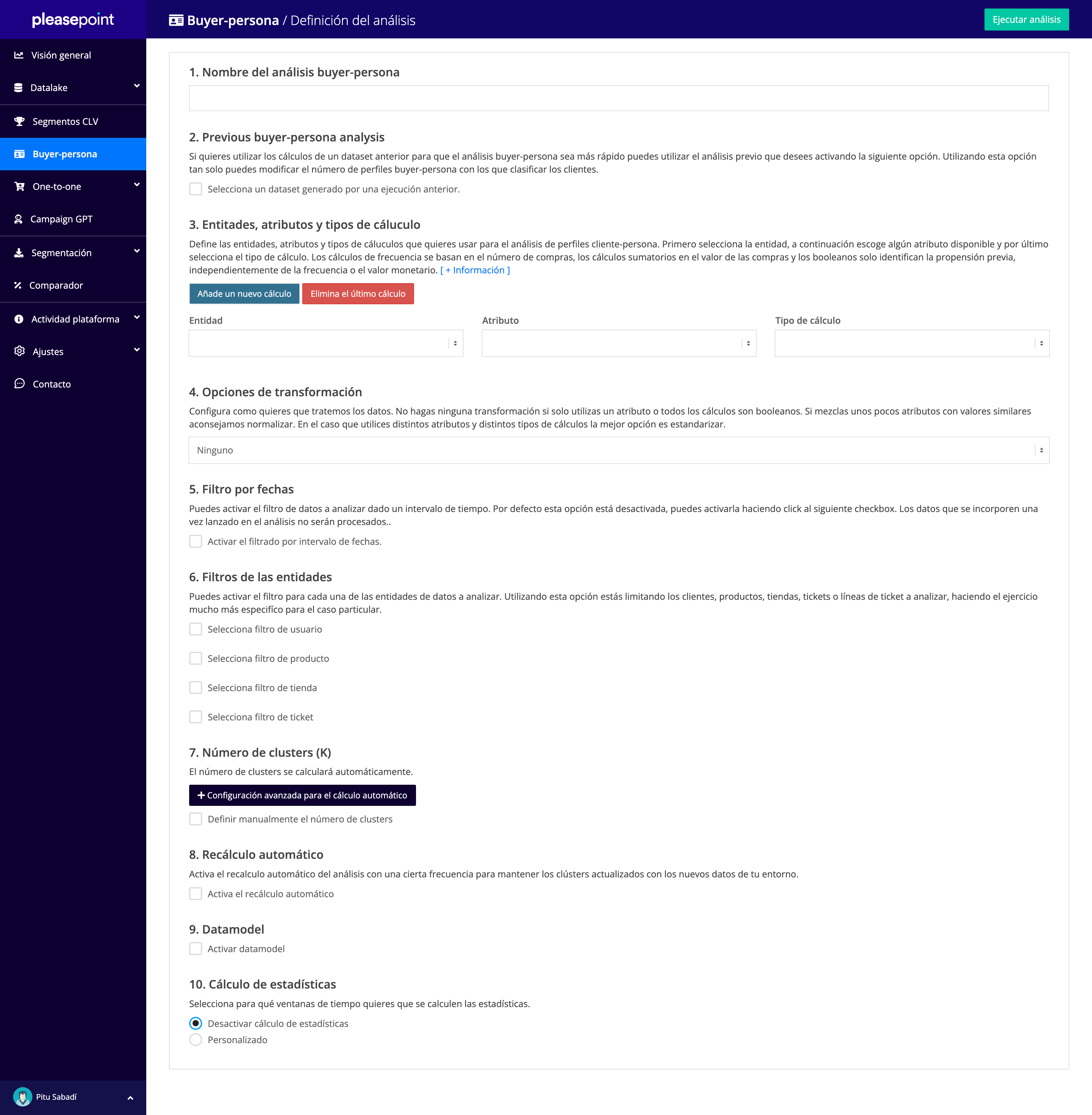
Here’s a step-by-step guide to configuring a new Purchase Propensity Datamodel in Pleasepoint’s buyer-persona module:
- Configure a new buyer-persona model: Access the Pleasepoint buyer-persona module and create a new customer classification analysis based on purchase propensity. This will serve as the starting point for your datamodel.
- Enable automatic recalculation: Ensure that you enable the option for automatic recalculation. This ensures your datamodel is always updated with the latest data.
- Schedule automatic recalculation: Define how often you want the automatic recalculation to occur. This depends on the dynamics of your business and how quickly customer preferences evolve.
- Activate the Purchase Propensity Datamodel: Enable the Purchase Propensity Datamodel so it can start generating information about your customers’ buying trends.
- Set the SFMC sFTP Path: Specify where the datamodel CSV file will be placed for use in Salesforce Marketing Cloud (SFMC).
- Name the file: Assign a meaningful name to the datamodel file. This file will typically be a CSV containing valuable data about your customers' purchase propensities in various categories.
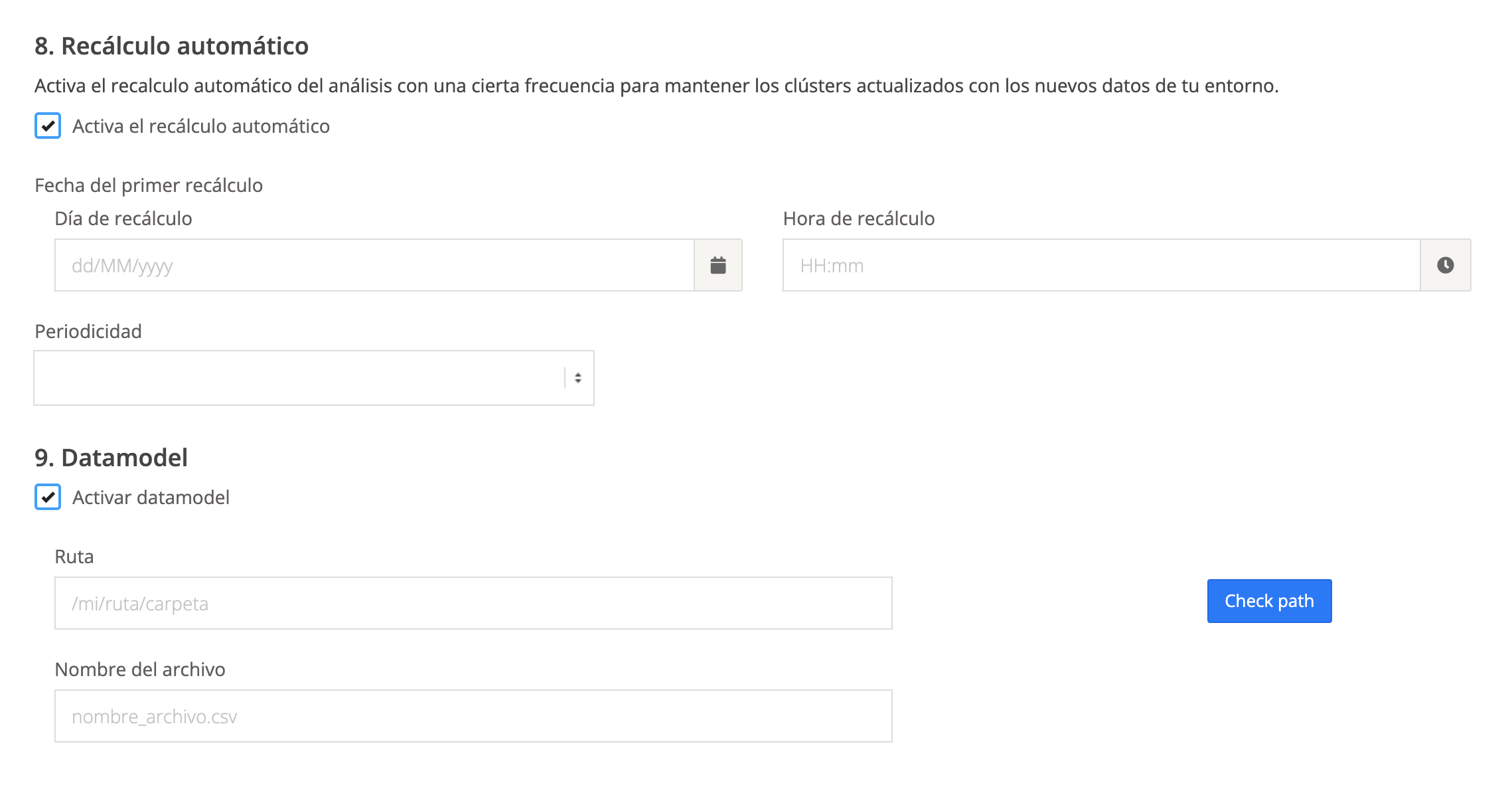
By following these steps, you’ll have your Purchase Propensity Datamodel configured and ready to drive your hyper-personalization strategy. Next, we’ll take a closer look at the underlying SQL structure of the datamodel to fully understand its capabilities.
Here are two blog posts that might interest you:
- Learn how to use Pleasepoint’s buyer-persona module based on purchase propensity..
- Turning data into sales growth: A case study on hyper-personalization in CRM strategy..
SQL structure of the Pleasepoint purchase propensity datamodel.
The Pleasepoint Purchase Propensity Datamodel is not only a powerful tool for analysis and prediction, but it also integrates seamlessly with SQL structures, offering incredible versatility to those passionate about data and technology.
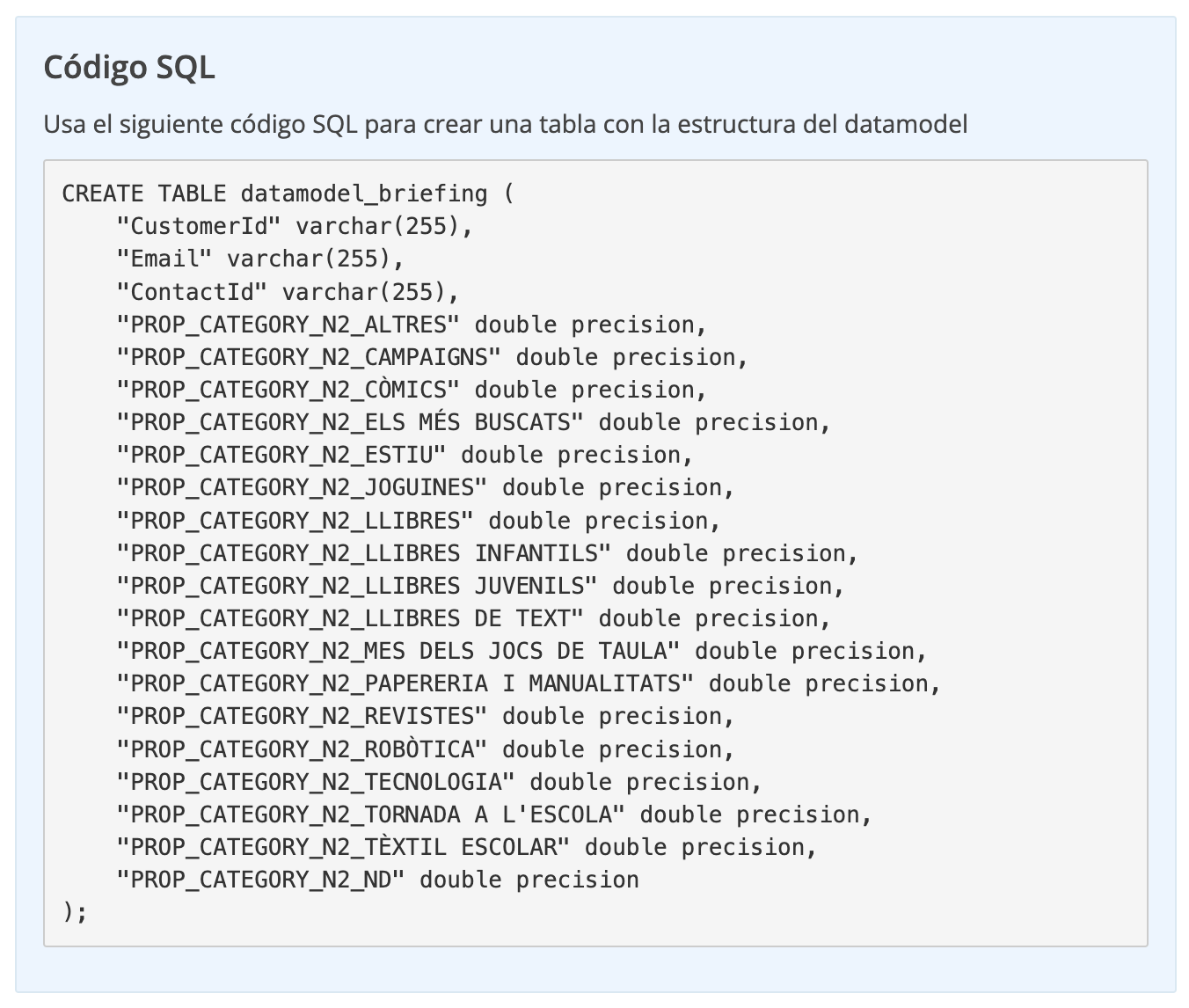
This integration provides extraordinary flexibility by allowing deeper access to and analysis of data, resulting in a richer understanding of your customers and the ability to make more precise marketing decisions.
Here is the SQL structure of the table for the Purchase Propensity Datamodel. This table stores valuable information about your customers’ propensity to purchase in various categories, enabling you to effectively personalize your strategies:
CREATE TABLE datamodel_propension_compra (
"CustomerId" varchar(255),
"Email" varchar(255),
"ContactId" varchar(255),
"PROP_CATEGORY_N2_ALTRES" double precision,
"PROP_CATEGORY_N2_CAMPAIGNS" double precision,
"PROP_CATEGORY_N2_CÒMICS" double precision,
"PROP_CATEGORY_N2_ELS MÉS BUSCATS" double precision,
"PROP_CATEGORY_N2_ESTIU" double precision,
"PROP_CATEGORY_N2_JOGUINES" double precision,
"PROP_CATEGORY_N2_LLIBRES" double precision,
"PROP_CATEGORY_N2_LLIBRES INFANTILS" double precision,
"PROP_CATEGORY_N2_LLIBRES JUVENILS" double precision,
"PROP_CATEGORY_N2_LLIBRES DE TEXT" double precision,
"PROP_CATEGORY_N2_MES DELS JOCS DE TAULA" double precision,
"PROP_CATEGORY_N2_PAPERERIA I MANUALITATS" double precision,
"PROP_CATEGORY_N2_REVISTES" double precision,
"PROP_CATEGORY_N2_ROBÒTICA" double precision,
"PROP_CATEGORY_N2_TECNOLOGIA" double precision,
"PROP_CATEGORY_N2_TORNADA A L'ESCOLA" double precision,
"PROP_CATEGORY_N2_TÈXTIL ESCOLAR" double precision,
"PROP_CATEGORY_N2_ND" double precision
);
To use this datamodel, you must first perform an ETL (Extract, Transform, Load) process to transfer the data to your preferred database. This will allow you to store and manage the purchase propensity information of your customers effectively.
In Salesforce Marketing Cloud (SFMC), you can create a Data Extension (DE) with the same structure as the datamodel table and set up an automation that reads the file and periodically enriches the DE.
This setup allows you to work with updated data and segment audiences based on their purchase propensity directly in SFMC.
One of the key advantages is the transparency in using purchase propensity in SFMC. You can easily segment your audiences based on purchase propensity and personalize your content according to these predictions.
Additionally, SFMC allows you to use AMPscript for dynamic personalization based on purchase propensity, meaning you can offer your customers highly relevant and timely content.
This SQL structure empowers you to analyze detailed data, make more informed decisions, and personalize your marketing strategies effectively. This versatility will help you achieve greater customer engagement and, ultimately, business growth.
Use cases of the purchase propensity datamodel (buyer-persona).
The Purchase Propensity Datamodel is an exceptionally versatile tool that provides clear advantages to your marketing strategies and customer relations.
Here, we will explore several concrete use cases that demonstrate how this tool can be an essential asset for your organization:
- Personalized Additional Campaigns: Create highly personalized additional campaigns based on your customers’ purchase propensity, offering them products or services that you know they are interested in.
- Hyper-Personalized Product Launch Campaigns: When launching new products, use purchase propensity to identify customers most likely to buy them and target them specifically.
- Purchase Repetition Journeys based on Propensity: Design automated journeys that encourage the repeat purchase of products related to each customer's preferences.
- Cross-Selling Journeys based on Propensity: Use purchase propensity to identify cross-selling opportunities and guide customers to complementary products they may be interested in.
- Personalization of Weekly Newsletter Content: Improve your weekly newsletters by personalizing the content according to each subscriber's purchase propensity, offering them relevant information and specific offers.
- Meta Advertising Audiences: Use the Purchase Propensity Datamodel to create segmented audiences for advertising on platforms like Meta, maximizing the impact of your ads by targeting users with a high propensity to buy.
- Special Offers and Segmented Discounts: Offer special deals and exclusive discounts to groups of customers with specific purchase propensities, incentivizing their purchases.
- Website and App Content Personalization: Adapt your customers' online experience by personalizing the content and recommendations on your website or app according to their purchase propensity.
- Detection of Emerging Trends and Preferences: Use the datamodel to detect emerging trends and preferences among your customers, allowing you to proactively adjust your inventory and product strategy.
In summary, the Purchase Propensity Datamodel is a powerful tool that can revolutionize your marketing strategies and customer relationships.
By precisely segmenting, personalizing communications, and leveraging individual preferences, you can improve customer retention and increase sales conversions, which translates into sustainable growth for your business.
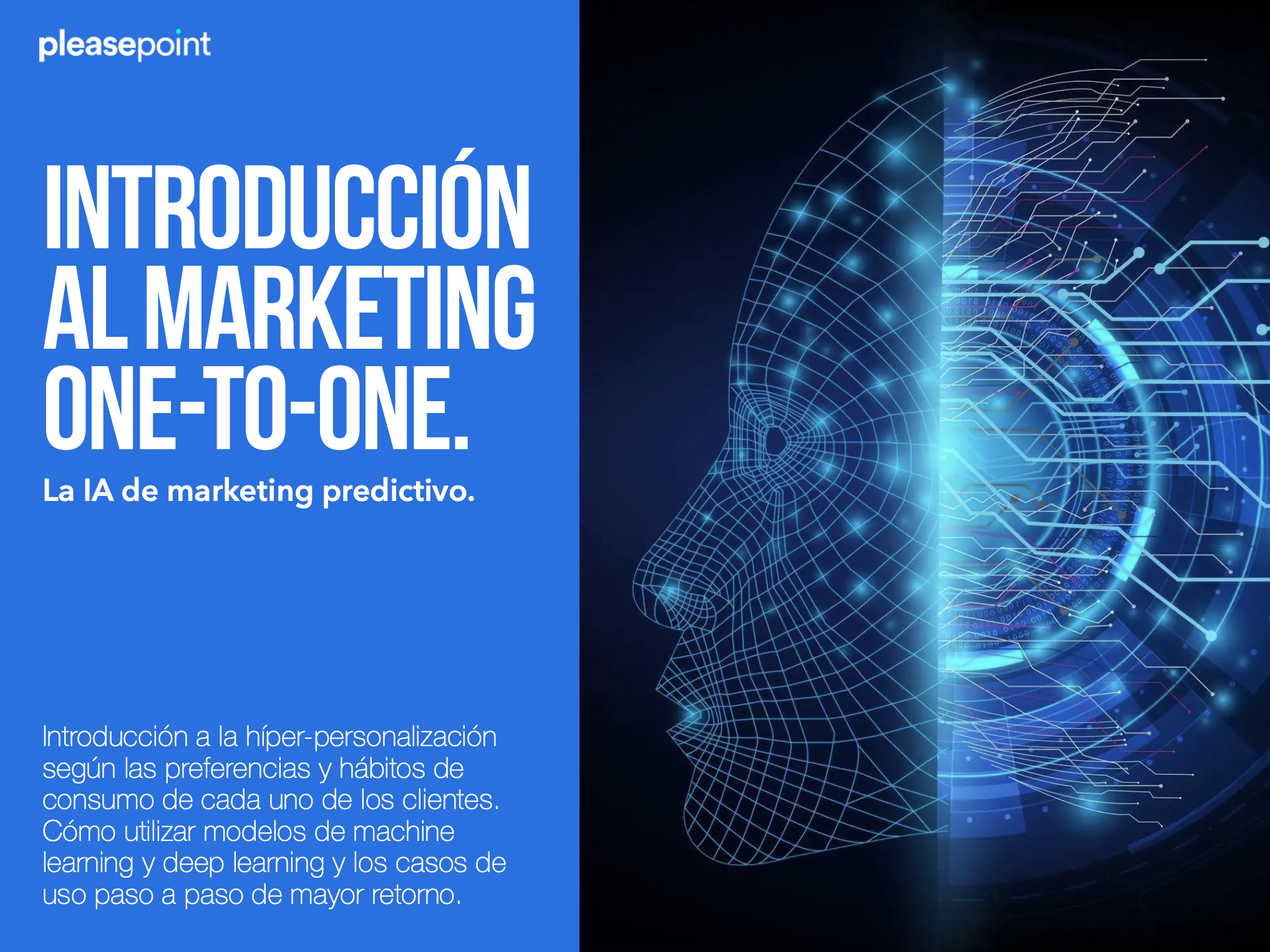
Download our eBook Introduction to one-to-one marketing and learn how to hyper-personalize your communication strategy and real-time interaction with each of your customers, increasing your marketing actions’ conversion to sales.
Examples of personalization based on purchase propensity.
The true magic of hyper-personalization materializes through the Purchase Propensity Datamodel. This powerful tool allows you to tailor your messages and offers precisely to the individual preferences of each customer.
Below, we explore concrete examples of how to implement hyper-personalization in your Customer Relationship Management (CRM) strategy:
- Hyper-Personalization of Content in Weekly Newsletters: Imagine sending weekly newsletters where each customer receives product recommendations based on their historical purchase preferences. If a customer has a strong propensity for science fiction books, the newsletter will highlight the latest releases in that genre. This personalization can significantly increase open and engagement rates, leading to a positive impact on sales.
- Micro-Segmented and Hyper-Personalized Additional Campaigns: Using insights from the Purchase Propensity Datamodel, you can launch specific campaigns for different customer segments. For example, if you identify a group with high purchase propensity for tech products, you can offer them an exclusive campaign of discounts on electronic gadgets. This hyper-personalization can lead to substantial increases in conversions and sales.
- Personalization of Content, Categories, and Products: It’s not just about recommending products—it’s about personalizing the entire shopping experience. This involves adapting the interface of your platform or website to show the categories and products a customer has the highest propensity to buy first. Additionally, you can suggest related products based on their previous purchases, creating a highly individualized shopping experience.
To illustrate the impact of these personalization strategies, we compared the results with a control group that did not receive personalized impacts. During the current year, we observed a significant increase of €1.8 million in sales, representing an impressive 10% growth.
This increase translates into a positive impact on sales growth for every 1,000 customers.
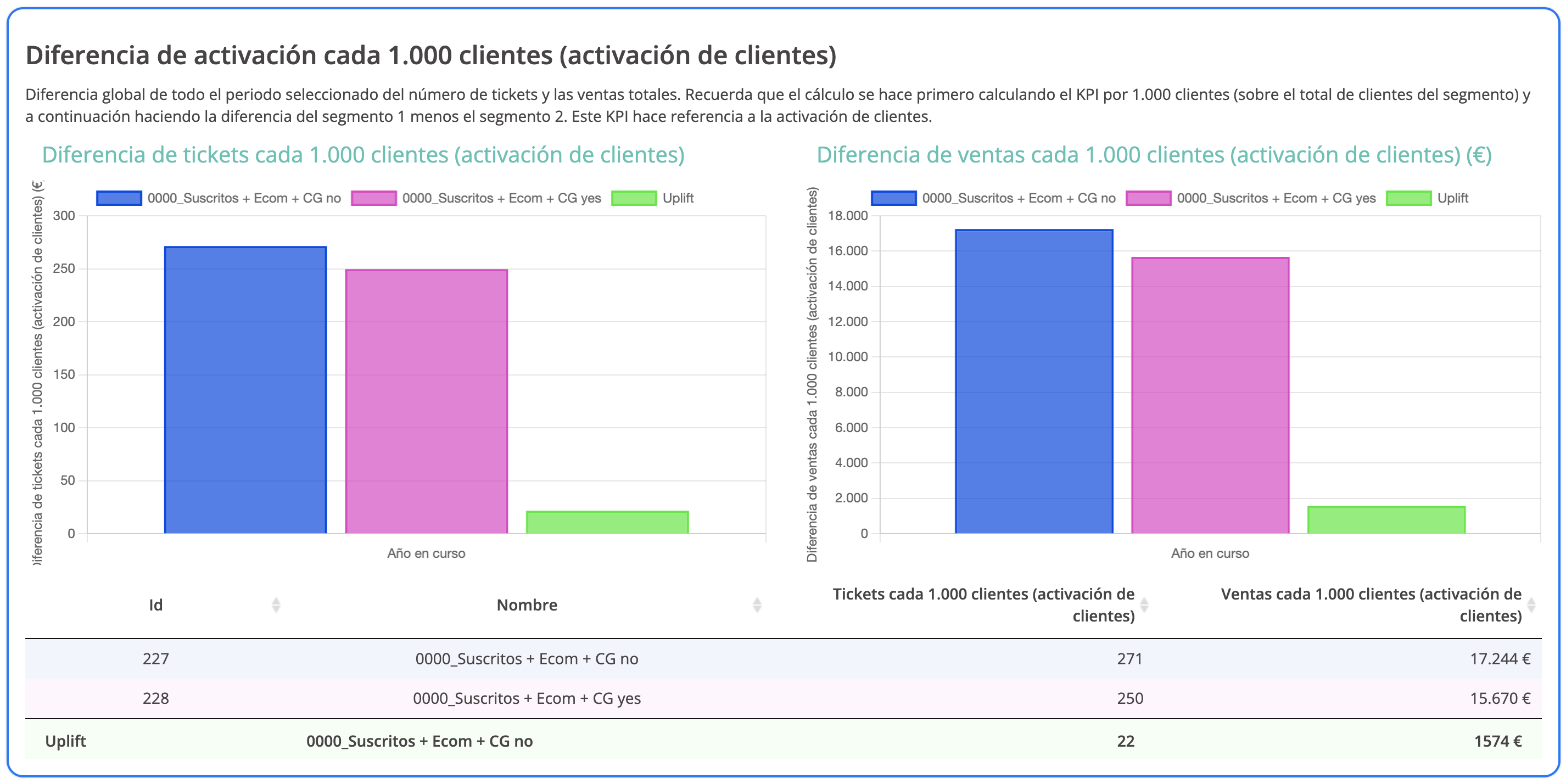
Additionally, valuable insights were gained to guide future strategies to further drive sales and improve the customer experience.

Hyper-personalization based on purchase propensity stands as a key pillar in CRM strategy, proving its effectiveness in increasing sales, improving customer retention, and enhancing the customer relationship.
By leveraging the power of the Purchase Propensity Datamodel, you can take your personalization strategy to the next level, generating tangible results for your business.
Benefits of using the buyer-persona datamodel in SFMC.
The Purchase Propensity Datamodel is a valuable asset in your Salesforce Marketing Cloud (SFMC) strategy. Not only does it provide a deeper understanding of your customers, but it also automates and optimizes various processes in your marketing campaigns.
Here are the key benefits of integrating this datamodel into your SFMC strategy:
- Automated Segmentation by Propensity: With the Purchase Propensity Datamodel, segmentation is no longer a manual task. You can automate the classification of customers based on their purchase preferences. This means you’re always sending the right message to the right group, saving time and ensuring the relevance of your communications.
- Automated Personalization by Propensity: Hyper-personalization becomes a reality. Using the datamodel, you can automate the personalization of messages, offers, and product recommendations. Each customer receives content tailored to their tastes and preferences, significantly improving the effectiveness of your campaigns.
- Higher ROI from Micro-Segmented and Personalized Campaigns: Being able to create campaigns targeted at very specific segments based on purchase propensity increases the likelihood of conversion. Micro-segmented campaigns typically have a higher return on investment because customers feel more connected to the messages and offers.
- More Relevant Communications: Your customers will notice the difference. Receiving highly relevant communications makes them more likely to engage and make purchases. This improves brand perception and strengthens customer loyalty.
- Greater Customer Engagement: Personalization based on purchase propensity not only drives sales but also increases engagement. Customers feel that you are proactively addressing their needs, fostering a stronger relationship.
- Cross-Selling Strategies: Identifying which complementary products may interest each customer becomes easier. You can implement precise cross-selling strategies, increasing the average purchase value.
- Repeat Purchase Strategies: Want to keep your customers coming back? The datamodel helps you create customer journeys designed to encourage repeat purchases. You can offer personalized incentives or timely reminders to keep your customers engaged.
- Optimized Promotions and Launch Communications: With precise data on purchase propensity, you can fine-tune your promotion strategies. You no longer need to waste resources on offers for customers who are already inclined to buy. Instead, you can target those promotions to segments that need an extra push.
In summary, integrating the Buyer-Persona Datamodel into Salesforce Marketing Cloud (SFMC) not only adds efficiency to your marketing operations but also enhances the customer experience and positively impacts your financial results.
By personalizing and automating your communications based on purchase propensity, you position yourself advantageously in today’s highly competitive market.
Download our eBook Enriching Customer Data and learn how to execute a personalization strategy based on the lifecycle and preferences of each of your customers. It has never been easier to start hyper-personalizing and increasing the performance of your marketing actions.
